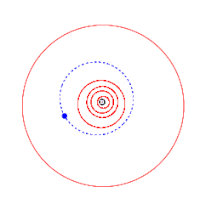9931 Herbhauptman
| Discovery [1] | |
|---|---|
| Discovered by | A. Mrkos |
| Discovery site | Kleť Obs. |
| Discovery date | 18 April 1985 |
| Designations | |
| (9931) Herbhauptman | |
Named after | Herbert A. Hauptman [1] (American mathematician) |
| 1985 HH · 1982 QJ1 1996 HA1 | |
| main-belt [1][2] · (inner)[3] Nysa [4] | |
| Orbital characteristics [2] | |
| Epoch 23 March 2018 (JD 2458200.5) | |
| Uncertainty parameter 0 | |
| Observation arc | 35.60 yr (13,004 d) |
| Aphelion | 2.7991 AU |
| Perihelion | 1.9573 AU |
| 2.3782 AU | |
| Eccentricity | 0.1770 |
| 3.67 yr (1,340 d) | |
| 329.47° | |
| 0° 16m 7.32s / day | |
| Inclination | 2.4717° |
| 157.21° | |
| 80.707° | |
| Physical characteristics | |
| 4.54 km (calculated)[3] 5.179±0.368 km[5][6] | |
| 4.438±0.0091 h[7] 4.44±0.020 h[8] | |
| 0.20 (assumed)[3] 0.239±0.042[5][6] | |
| S [3][9] | |
| 13.6[6] 13.629±0.001 (R)[7] 13.660±0.090 (R)[8] 13.7[2] 14.06±0.32[9] 14.08[3] | |
9931 Herbhauptman, provisional designation 1985 HH, is a stony Nysian asteroid from the inner regions of the asteroid belt, approximately 5 kilometers (3 miles) in diameter. It was discovered on 18 April 1985, by Czech astronomer Antonín Mrkos at the Kleť Observatory in former Czechoslovakia.[1] The S-type asteroid has a rotation period of 4.44 hours.[3] It was named after American mathematician and Nobel laureate Herbert A. Hauptman.[1]
Orbit and classification
[edit]
Herbhauptman is member of the Nysa family (405),[4] one of the largest asteroid families.[10]
It orbits the Sun in the inner main-belt at a distance of 2.0–2.8 AU once every 3 years and 8 months (1,340 days; semi-major axis of 2.38 AU). Its orbit has an eccentricity of 0.18 and an inclination of 2° with respect to the ecliptic.[2] The body's observation arc begins with its first observations as 1982 QJ1 at Palomar Observatory in August 1982.[1]
Physical characteristics
[edit]Herbhauptman has been characterized as a stony S-type asteroid by Pan-STARRS' survey.[3][9]
Rotation period
[edit]In 2014, two rotational lightcurves of Herbhauptman have been obtained from photometric observations in the R-band by astronomers at the Palomar Transient Factory in California.[7][8] Lightcurve analysis gave a rotation period of 4.438 and 4.44 hours with a brightness amplitude of 0.15 and 0.21 magnitude, respectively (U=2/2).[3]
Diameter and albedo
[edit]According to the survey carried out by the NEOWISE mission of NASA's Wide-field Infrared Survey Explorer, Herbhauptman measures 5.179 kilometers in diameter and its surface has an albedo of 0.239,[5][6] while the Collaborative Asteroid Lightcurve Link assumes a standard albedo for a stony asteroid of 0.20 and calculates a diameter of 4.54 kilometers based on an absolute magnitude of 14.08.[3]
Naming
[edit]This minor planet was named after American mathematician Herbert A. Hauptman (1917–2011), who was awarded with the Nobel Prize in Chemistry for developing direct methods for the determination of crystal structures in 1985.[1] The official naming citation was published by the Minor Planet Center on 28 September 2004 (M.P.C. 52767).[11]
References
[edit]- ^ a b c d e f g "9931 Herbhauptman (1985 HH)". Minor Planet Center. Retrieved 2 May 2018.
- ^ a b c d "JPL Small-Body Database Browser: 9931 Herbhauptman (1985 HH)" (2018-03-27 last obs.). Jet Propulsion Laboratory. Retrieved 2 May 2018.
- ^ a b c d e f g h i "LCDB Data for (9931) Herbhauptman". Asteroid Lightcurve Database (LCDB). Retrieved 2 May 2018.
- ^ a b "Asteroid 9931 Herbhauptman – Nesvorny HCM Asteroid Families V3.0". Small Bodies Data Ferret. Retrieved 27 October 2019.
- ^ a b c Masiero, Joseph R.; Mainzer, A. K.; Grav, T.; Bauer, J. M.; Cutri, R. M.; Dailey, J.; et al. (November 2011). "Main Belt Asteroids with WISE/NEOWISE. I. Preliminary Albedos and Diameters". The Astrophysical Journal. 741 (2): 20. arXiv:1109.4096. Bibcode:2011ApJ...741...68M. doi:10.1088/0004-637X/741/2/68. S2CID 118745497.
- ^ a b c d Mainzer, A.; Grav, T.; Masiero, J.; Hand, E.; Bauer, J.; Tholen, D.; et al. (November 2011). "NEOWISE Studies of Spectrophotometrically Classified Asteroids: Preliminary Results". The Astrophysical Journal. 741 (2): 25. arXiv:1109.6407. Bibcode:2011ApJ...741...90M. doi:10.1088/0004-637X/741/2/90. S2CID 118700974. (catalog)
- ^ a b c Waszczak, Adam; Chang, Chan-Kao; Ofek, Eran O.; Laher, Russ; Masci, Frank; Levitan, David; et al. (September 2015). "Asteroid Light Curves from the Palomar Transient Factory Survey: Rotation Periods and Phase Functions from Sparse Photometry". The Astronomical Journal. 150 (3): 35. arXiv:1504.04041. Bibcode:2015AJ....150...75W. doi:10.1088/0004-6256/150/3/75. S2CID 8342929.
- ^ a b c Chang, Chan-Kao; Ip, Wing-Huen; Lin, Hsing-Wen; Cheng, Yu-Chi; Ngeow, Chow-Choong; Yang, Ting-Chang; et al. (August 2015). "Asteroid Spin-rate Study Using the Intermediate Palomar Transient Factory". The Astrophysical Journal Supplement Series. 219 (2): 19. arXiv:1506.08493. Bibcode:2015ApJS..219...27C. doi:10.1088/0067-0049/219/2/27. S2CID 17093124.
- ^ a b c Veres, Peter; Jedicke, Robert; Fitzsimmons, Alan; Denneau, Larry; Granvik, Mikael; Bolin, Bryce; et al. (November 2015). "Absolute magnitudes and slope parameters for 250,000 asteroids observed by Pan-STARRS PS1 - Preliminary results". Icarus. 261: 34–47. arXiv:1506.00762. Bibcode:2015Icar..261...34V. doi:10.1016/j.icarus.2015.08.007. S2CID 53493339.
- ^ Nesvorný, D.; Broz, M.; Carruba, V. (December 2014). "Identification and Dynamical Properties of Asteroid Families". Asteroids IV. pp. 297–321. arXiv:1502.01628. Bibcode:2015aste.book..297N. doi:10.2458/azu_uapress_9780816532131-ch016. ISBN 9780816532131. S2CID 119280014.
- ^ "MPC/MPO/MPS Archive". Minor Planet Center. Retrieved 2 May 2018.
External links
[edit]- Asteroid Lightcurve Database (LCDB), query form (info Archived 16 December 2017 at the Wayback Machine)
- Dictionary of Minor Planet Names, Google books
- Discovery Circumstances: Numbered Minor Planets (5001)-(10000) – Minor Planet Center
- 9931 Herbhauptman at AstDyS-2, Asteroids—Dynamic Site
- 9931 Herbhauptman at the JPL Small-Body Database
